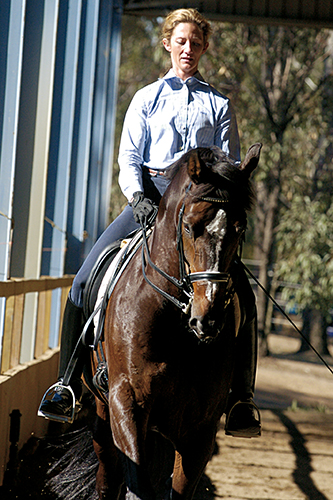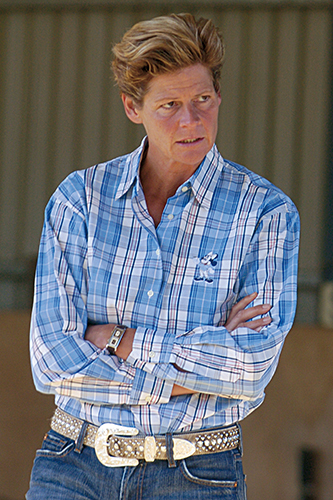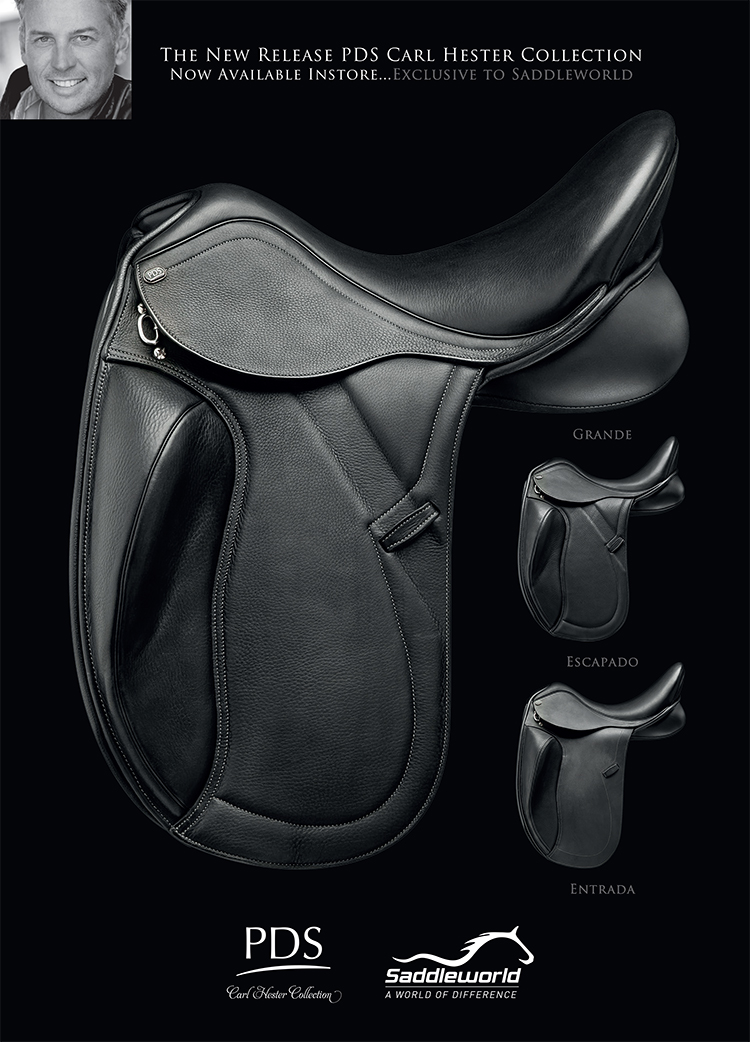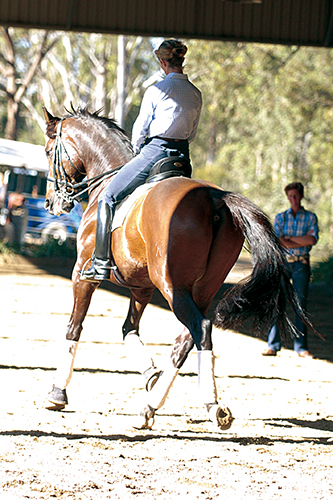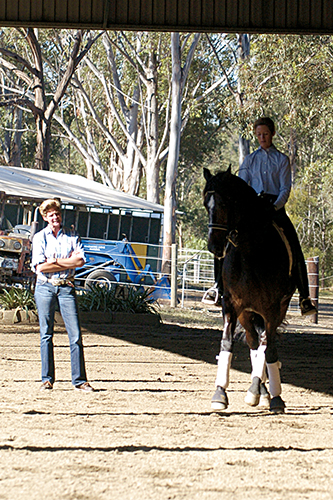Story by Chris Hector and Photos by Roz Neave
There was one Australian rider who was particularly over-joyed when news came through that Ulla Salzgeber had agreed to help the Australian team in the lead up to the WEG in Aachen in 2006, and that was Kelly Layne – because Kelly had already spent almost a year working with Ulla in Germany and she knew what a super instructor the World Cup champion was…
I guess it is some measure how far down the track Australia has come that our visiting superstar instructor should spend the first ten minutes getting rid of passage steps, and that is what Ulla is doing with Kelly and her imported Hanoverian, Amoucheur. The dark brown gelding can get awfully passagey in his normal trot (remember when we were so ignorant that we thought this pissage was smart?) and Ulla is having none of it:
“Trot more normal, ask for no more or he makes a quick passage. Let him a little more alone, don’t try to help him. Keep going forward, but you are pushing him too much. Open your legs, let him trot a normal trot. No passagey steps, open your upper legs and let him relax.”
“You have got extended trot, passage and collected trot, but you have lost the normal trot.”
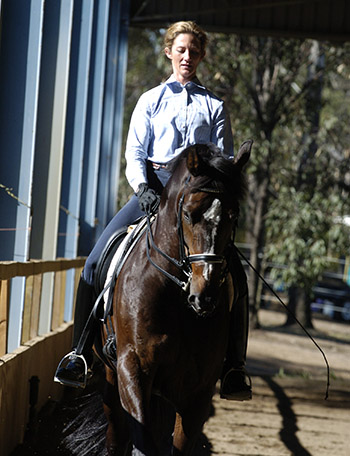
Time to work on the half pass, and once again, we see Ulla’s insistence on working in a competition frame and focus:
“Shorten the outside rein, shorten the neck but don’t lower the neck, keep the rhythm in the half pass, don’t push at the end. Open your legs and take them a little further back and leave them there, get more bend for the half pass, and keep the outside rein.”
And we end up with a lovely flowing half pass…

Time to work on the all important square halt to start the test. And this time Kelly has a messy stop and Ulla’s voice goes up a few decibels: “NO, this was not a nice halt. Higher in the neck, higher in the neck, now halt. That was better until he stepped back!”
“Do it again, shorten the neck, make him slower, open your legs, half half. Stop. YA.”
“Kelly remember slower, everything slower…”
Having spent all that time getting rid of the passage steps and establishing working trot, guess what we want? Yep (or to be really Ulla-ish, Ya) we want passage.
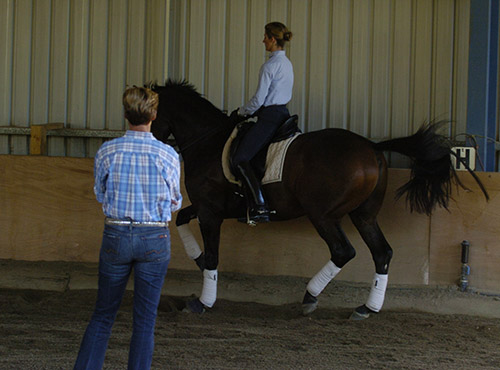
“Collect only with the reins, and go to passage. Open his poll and shake him loose in the transition from trot to passage. BORING, I want this passage to be boring – keep this boring passage, in everything I want it boring boring and relaxed.”
Know what? It isn’t boring at all, it is beautiful passage! Bravo.
more on Ulla’s teaching follows
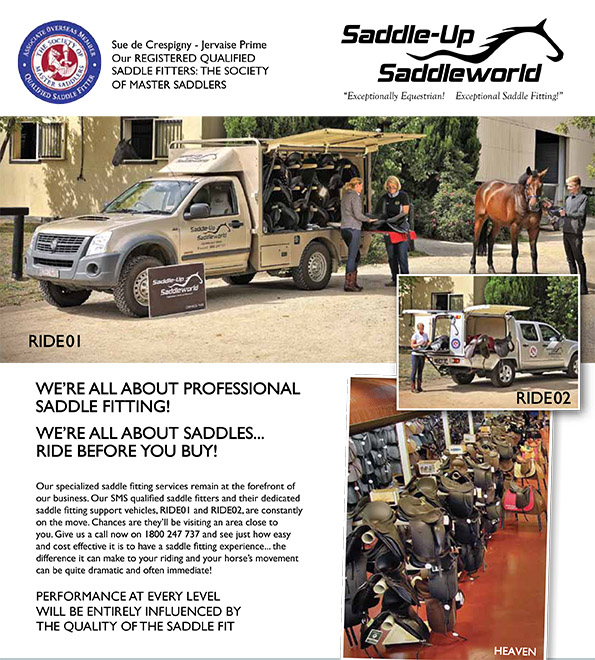
Ring Saddle-Up and arrange to discuss your new saddle at the Australian Dressage Championships at Boneo Park 03 9727 4000 or 1800 247 737
It is interesting the riders’ reaction to Ulla. Now there is no doubt that she is an absolutely brilliant teacher with an amazing eye for detail, but many of the things she is asking the riders to do, things they hail as amazing revelations, are exercises that countless Australian instructors have tried to get them to do, many times before. Anyone who has had a lesson with Malcolm Barns, should well know the ‘canter your circle like a square’ exercise… I guess what is really operating here is that Ulla’s presence and her undoubted standing, makes the riders react differently and old recipes suddenly have new effects.
Certainly Kelly is getting a great result when she turns her circle into a square.
“No flexion, just a straight horse, I don’t want him flexed. I want him on the outside rein. Don’t flex him all the time, he is always curved like a banana. Keep him straight, ride him forward, ride him slower…”
How lucky we are to have a trainer of Ulla Salzgeber’s brilliance take an interest in dressage in our country? How lucky are we that she comes at a time, when we have horses and riders, ready to take the next step. How sophisticated a dressage nation have we become when daughters follow their mothers into the ranks of Grand Prix dressage…
“I’m actually very fortunate, because I am a second generation Grand Prix dressage rider. My mum rode Grand Prix, and I’ve ridden Grand Prix,” Kelly proudly tells me as we take time out to gather her story.
And you paid your dues in the Show Ring before that?
“Oh god, do we have to go there. It was a fun thing to do when I was younger but always I had dressage lessons. When I was 11, I won my first Australian Pony Club Dressage Championship, then won it again the following year, so I was pretty much hooked on dressage. I still did a bit of showing, but always in the show ring I got told I rode too much like a dressage rider, and always in the dressage, I got told I rode too much like a show rider!”
But you see the riders who’ve done some show riding and they do generally sit a bit nicer than the ones that have come straight through dressage? And they show that bit better even in a dressage test, some of it is quite useful?
“Absolutely. I really enjoyed my time showing, I got a chance to ride lots of different horses. I got to spend some time with Vince Corvi, and he really trains his horses in the dressage way, and that’s why I think they are successful in the show ring, you can actually make them do the transitions, you can ride walk, trot and canter.”
But at eleven you decided you wanted to be a dressage rider?
“Pretty much. I was lucky, my mum bought me a very good horse from New Zealand, Abbey Hill, who carried me to many Champion Girl Rider titles at Royal Shows, but she was trained to Prix St Georges. I competed Prix St Georges with her when I was sixteen, and when I was seventeen, we like came 10th in Prix St Georges at the Dressage Nationals, that was a pretty big deal. The following year, I rode my mum’s horse, Adonis, in Grand Prix, when I was eighteen. You just get more hooked as you go along.”
And who was the instructor then?
“Clemens Dierks, absolutely. He was the one that pushed us all through, he kept bringing everyone back in line and gave us direction.”
And kept saying that the main game was Grand Prix?
“Yes, Grand Prix is the game. He got me started and it wasn’t until I went to Ulla’s that it all changed again. Before Ulla it was the ‘oh it doesn’t really matter about the competition, it is more about the training’ attitude. I found that I rode dressage tests, but I was more schooling the horse through the dressage test and I wasn’t riding competition dressage.”
“When I went to Ulla’s, she changed everything. There the emphasis was on being a competition rider, and having your head around competition dressage – which is a bit different from classical just training dressage.”
So what made you take off to Germany and Ulla’s – that’s a big investment of time, money, effort…
“Yep. I think certain events took place that all made the puzzle fit together. First of all I somehow managed to acquire my horse, Amoucheur. That was step one. Within no time at all, Ulla was coming to Australia, and she was going to do Equitana in Brisbane, this is just months after I got this horse. I had the chance to do the clinic, and all the pieces started to fit in together. I very cheekily said to her one day, ‘is there any chance of someone like me, coming to train at your stable?’. She said ‘Oh yeah, it’s possible.’ I said, ‘what if I wanted to bring my horse?’ Well she said, ‘that we can do’ – it was like she decided if I was going to make that big a commitment, then she will make the same commitment. Financially it’s a huge commitment, and psychologically, it is a big commitment, you have a family, you have a business, and you have to put everything on hold!”
How long were you with Ulla?
“Nine months, it was the biggest nine months of my life. We did lots of competitions, which I wasn’t prepared for. It wasn’t in my mind when I was thinking of going over there. I was thinking of going to train and learn more, but we learnt on the road. We learnt through the competitions and what went right and what went wrong, and the de-briefing after every competition. It was so much more sport than I had ever realised. It was real sport, and I had never been involved with the idea of dressage as real sport.”
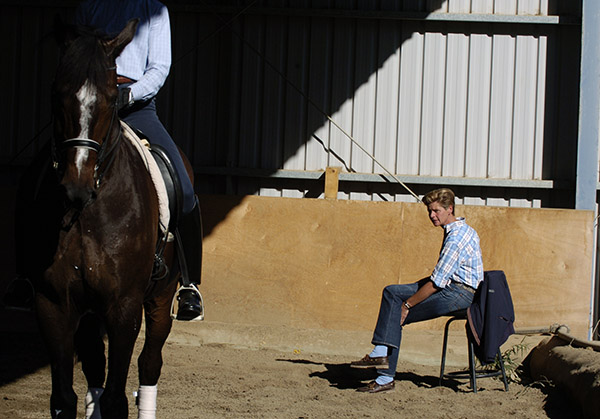
I don’t think a lot of people realise that Ulla before she discovered Rusty, was primarily a rider coach, and the mentor of young riders, that was her profession?
“Absolutely, and she is a phenomenal teacher. She has an excellent grasp of English, all those things have made a difference. For me the pieces all started to fit together and they still keep fitting together.”
Was it a hard time?
“It was tough, very tough, but it only stayed in the arena, what we did in the arena, stayed in the arena. There was such a nice balance, and I see that in Ulla’s life. She has such an excellent balance in her life. Family comes first, then dressage, then her business, and everything is balanced. It’s not extreme, okay it is extreme in its area. When she rides dressage it is extreme. When she is with family it is extreme, sit down, big lunches, silver service, everybody together. It is extreme but one thing doesn’t overwhelm the other, that is really nice.”
“But the lessons were hard. It was the steepest learning curve.”
In what way hard?
“Physically very hard, she wants you to be able to do things without her being able to see them. In your mind, she doesn’t want you riding with the horse, she wants you riding six strides ahead of the horse, you are making adjustments before they happen, and you are planning for them. Mentally, I could handle it quite well, but the physical side of how she wanted you to sit…”
And that was different from how you were taught to sit in Australia – in what way?
“She saw little weaknesses. Like your elbows sticking out, and a tiny change like that and you have pain somewhere else. Especially the hands, she is so strict about your hands. She tied my hands to the saddle, and said ‘now ride the Grand Prix’. Tied my feet to the girth, and said ‘now ride the Grand Prix’.”
I would have thought that as Australian riders went, you were fairly styley?
“I thought I was… but she sees so much, and now I really understand it. For example, pushing forward, I might not have given in my hands, but if you give with your elbows, or give with your stomach, you don’t get the same reaction. It was so important that you sat exactly how she wanted you to sit, otherwise, what she said, didn’t work. It’s hard with a lot of trainers. Unless you are doing it exactly how they want you to do it, it may not work, and people go home and try it, but they have something wrong, like their elbows out, or their toes wrong, or their leg too far back or too far forward, and they try to do what they’ve watched her do in a lesson, and it doesn’t work. The sitting position is really important.”
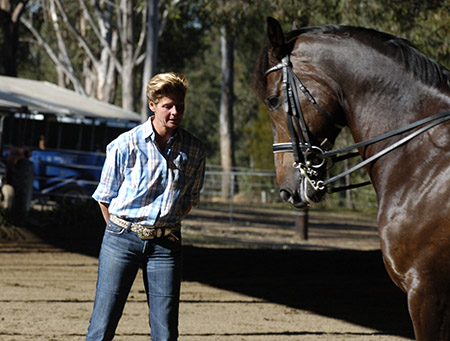
Tell me about your horse, Amoucheur?
“He’s a funny one. He’s different from what most people think. Everybody thinks he is really hot and he is not a hot horse, he’s a spooky horse, and I think that is very different. I can put as much leg on him as I want, and he doesn’t get hot to my leg, but he might react to something sitting in the corner of the arena and want to spook away from it.”
“When I first went to Ulla’s I said ‘oh he is so sensitive, I can’t kick him’. She would say, kick him, more leg, and I’d say I can’t, he is so sensitive. She said, your horse is not sensitive at all. A sensitive horse, when you use your leg, reacts the right way and quickly – you horse doesn’t react, he just runs away! That was very different, her idea of sensitive, and mine. He really accepts the leg very well.”
But it must be heart-breaking at times because he can do some sensational work, and you must think whacko, here we go, and suddenly he snaps on you?
“It’s all a big learning curve with that. He is very linked to me. Right from the beginning Ulla said to me ‘you’re nervous’ and I never believed her, ‘no I’m not’. Now I am starting to learn that I do get nervous, and it is something I have to learn to control myself. The concentration is what makes it all work.”
“At the Sydney CDI, I had done a really good test, and I came across the final diagonal in extended trot and he was just sailing, came through the corner, and I remember thinking ‘I’m home and hosed, I’ve done it’ – it was the best lesson for me, because I’ll never do it again, I’ll ride all the way to the final halt and I will never let that happen again. But I relaxed, turned, came up the final centre line and he leapt to the side, spun a circle – okay I kicked him a couple of times, got him back on the centre line, did a piaffe for three 8s and two 7s, passaged and halted and finished the test – but I stopped thinking for one second in the test… I’m noticing it more often, I think, wow that was good, and bang – he shies!”
So what are you hoping to get out of this clinic?
“The next step. And I am someone who loves the pressure, I thrive under her pressure. I love the intensity – the level of concentration is like an adrenalin rush. I find with her you get into a level of concentration, ‘the zone’ she calls it, and she is one person who can put me in the zone.”
Specific issues?
“Just how to control the power. At the last clinic in Brisbane, I said ‘I think my trot is a bit boring’ – he always has a nice trot but it is not like hers. And she said, ‘yes it is, it is boring, and this is how you make more’ – okay we got more, but I lost a bit of control. I am hoping she will help me control that power more, in the extended trots he tends to get so big that he gets irregular and he thinks he can fly. No you have to keep more collection on the hind legs, and you have to stay more on the hind legs – Ulla has the best eye for it, and she knows what I am capable of, which is scarey, she knows I can do what she says – now I just have to do it.”
I hope reading this, you don’t get the impression that Ulla is some kind of fierce martinet with her YA’s and do it agains. She is a very warm funny person, and laughs more often than she growls. She laughs when I ask her, is this a new concept in teaching dressage – I want it boring?
“No – but she is chasing him so much forwards and I don’t know what she is looking for. This is too much what she is doing.”
But you could see when you asked for ‘boring’ it became nicer and softer and rounder…
“She has to relax, and when she relaxes, the horse gets relaxed. Boring she understands, then she relaxes… only normal, normal, normal.”
And it is easy to get that bad passage into the trot?
“The bad passage and the bad collected trot, because it is all full of tension, and the tension has to go away, this only goes away when she thinks ‘oh I don’t have to do so much…’ If she does it less, then it will get better. She will see it on the tape, and tomorrow she will change totally. When she sees the difference when she does less.”
The same with the passage, with less it was better?
“It was beautiful, and with the higher front leg, everything was much better.”
So sometimes it is better to do less than more?
“Most of the time.”


